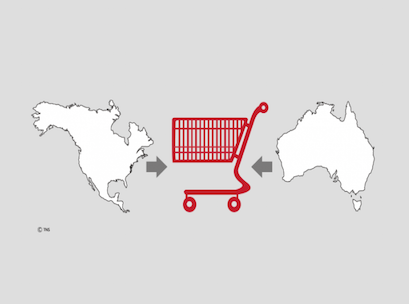As any person in business, our primary goal is to increase revenue. Whether that be through higher sales, increased conversions, improved relationships or reduced costs – the ultimate result = increased sales. There is a method which many retailers often neglect because it is right under their noses and requires very little expenditure, if any. It simply requires the analysis of your own store’s data. The method is referred to as ‘money mapping’ and it will change the way you do busi
ness.
Do you know which section or fixture in your store makes you the most money?
If you know where your money is coming from, you can maximise the potential of that location to make the most money possible from that fixture. For example, if you know your second rail gets the most foot traffic, you can place your newest dress or most weather appropriate item there.
Ramsay and Ramsay demonstrate the massive benefit to understanding where the money is generated on your sales floor and how to use that information to make more money from the stock you already have. Having a cloud based point of sale system will clearly show you what is selling the most. However, to take it a step further, rather than guessing what stock will most likely sell better in what location, money mapping shows you real data from real sales in your store so that you can sell more of what people want.
Here are the clear six steps you need to ensure you can money map your sales floor and inevitably increase your sales within just a few weeks, if not days.
Track your sales
Map your space every week using the system below. Create a map of your sales floor numbering the top 10 best sellers and their exact location in the store.
Top 10 best sellers (either men, women’s or both):
No 1 – Fixture 5
No 2 – Fixture 1
No 3 – Fixture 1
No 4 – Fixture 7
No 5 – Fixture 3
No 6 – Fixture 2
No 7 – Fixture 2
No 9 – Fixture 9
No 10 – Fixture 10
Keep it simple
Use a line, square or circle to show each fixture or area of your business. Get an analysis of your sales that shows your different pieces of stock and the quantity you sold. Place the total amount for each item where is lives in your store. Done each week, this ‘money mapping’ can give you a $$$ value to each fixture. It can help you understand the flow of traffic around your space/shop.
Once you’ve mapped your weekly sellers for a period of time, can you see how your highest selling items will begin to migrate to the front of the store, resulting in higher sales?
Make it meaningful
Date your money maps so your results have context. If it was the middle of winter it won’t come as a surprise that the jumpers, jackets, and boots sold well. But, you will be able to look back and see what products sold on special occasions like Mother’s Day. Record the factors effecting your trade so you can learn from them and use them to your advantage.
The 3 P’s
When you’re looking at your sales on your map, ask yourself the following:
Placement – is high/low on the list because it isn’t easy to find, hidden by other products, on the back of a floor fixture? Has it been moved recently?
Pricepoint – is it the right ‘grab it now’ price to be on your point of sale, is it too cheap to be on your best selling fixture?
Personal preference – have you been hiding this item or range because you personally don’t like it. It might be you subconsciously don’t think it is going to sell so you put it in a low traffic area. But wait, everyone’s got their own taste – it might be your next cash cow!
Using your findings
Once you have looked at your sales and moved stock to where you think it should be, believe in your instincts. Give it a chance! Wait at least two weeks to see a difference in sales. There may be Factors Affecting Trade on one day that make your move look ineffective, but if you give it at least two weeks you’ll have a more reliable result.
Be reactive
If you suddenly get a storm or bad weather in your area, why would you have bikinis on your best selling fixture. If you date your money maps and file them, you can refer back to a map from a time of year with the same weather and see what stock, where on your floor, made you the most money and do the same.
Very simply, if you can track where your cash flow is generated in your business, you repeat the success. If you keep track of it on your money map, you can re-use and display successful items and record any items that don’t work so well. The physical area you have can be used for displaying the right product in the right place at the right time to so that you give your customers even more opportunities to purchase.
Aaron Blackman is founder and CEO of Retail Express, a cloud-based retail management system. Connect with Aaron on LinkedIn.

